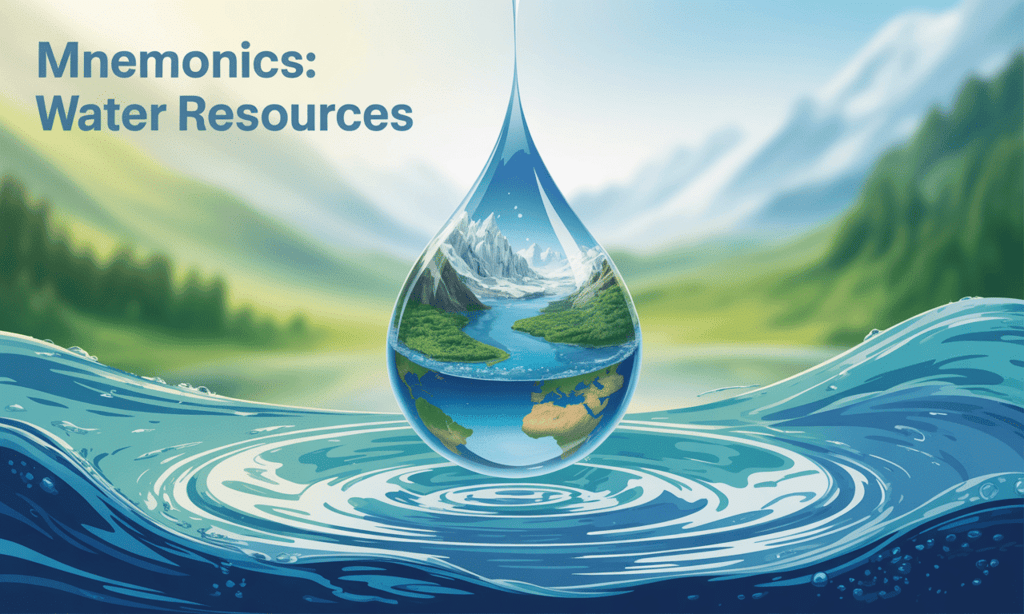Mnemonics: Water Resources | Social Studies (SST) Class 10 PDF Download

1. Earth's Water Resources
Mnemonic: "SWEET 3"
Interpretations:
S: Saltwater makes up 97%
W: Water cycle renews freshwater
E: Evaporation from oceans and lakes
E: Essential sources – runoff and groundwater
T3: Three percent is freshwater
Explanation: Earth’s surface is covered by 71% water. Of this, 97% is saltwater and only 3% is freshwater. Water is renewed through the hydrological cycle involving Evaporation, Precipitation, and Collection. Freshwater sources include runoff and groundwater.
2. Water Scarcity and Conservation
Mnemonic: "PAID SCARCE"
Interpretations:
P: Population growth increases water demand
A: Agriculture overuses water for irrigation
I: Industrial growth strains supply
D: Dry regions face natural scarcity
S: Scarcity results more from misuse
C: Contamination from chemicals and waste
A: Access inequality across social groups
R: Rural development via Jal Jeevan Mission
C: Crop change to drought-resistant varieties
E: Electricity (hydropower) contributes to demand
Explanation: Despite water’s abundance, overuse, contamination, and unequal access cause scarcity. Growing population, industrialization, and irrigation needs intensify the issue. Government initiatives like JJM target rural water access.
4. Multi-Purpose Dams
Mnemonic: "I FEW RICE"
Interpretations:
I: Irrigation for agriculture
F: Flood control measures
E: Electricity generation (hydel power)
W: Water supply for domestic and industrial use
R: Recreation through water bodies
I: Inland navigation
C: Commercial fish breeding
E: Ecological regulation attempts
Explanation: Dams serve multiple purposes such as irrigation, power generation, and water supply. Projects like Bhakra–Nangal and Hirakud integrate these uses for broader benefits.
5. Multi-Purpose Dams – Uses
Mnemonic: “I FEW FIR”
I: Irrigation
F: Flood control
E: Electricity (hydel power)
W: Water supply (domestic/industrial)
F: Fish breeding
I: Inland navigation
R: Recreation
Explanation: Dams serve multiple purposes, making them vital for development.
6. Disadvantages of Dams
Mnemonic: “FLOODS DISPLACE”
F: Fragments river ecosystems
L: Loss of aquatic biodiversity
O: Over-sedimentation
O: Over-irrigation leads to salinization
D: Displacement of locals
S: Social disputes over water
D: Dam failure risks floods
I: Inequality in water access
S: Soil erosion
P: Pressure to grow commercial crops
LACE: ecological Losses, Arable land decline, Conflict, Environmental imbalance
Explanation: While useful, dams also create serious ecological and social problems.
7. Rainwater Harvesting (RWH)
Mnemonic: “TANKS”
T: Traditional tankas (Rajasthan)
A: Arrest rainwater from roofs
N: Natural filtration (sand, brick)
K: Keep water for dry seasons
S: Safe drinking water source
Explanation: Rooftop rainwater harvesting is reliable, especially in dry regions like Rajasthan or Shillong.
8. Bamboo Drip Irrigation (Meghalaya)
Mnemonic: “BAMBOO”
B: Bamboo pipes carry water
A: Ancient (200-year-old) system
M: Minimal wastage
B: Based on gravity
O: Optimal for hilly terrain
O: Outflow is drop-wise for plant roots
Explanation: Traditional, eco-friendly system used in Meghalaya, effective for water conservation.
|
66 videos|614 docs|79 tests
|
FAQs on Mnemonics: Water Resources - Social Studies (SST) Class 10
| 1. What are the primary sources of Earth's water resources? |  |
| 2. How does water scarcity affect communities and ecosystems? |  |
| 3. What are the benefits of multi-purpose dams? |  |
| 4. What are some disadvantages of constructing dams? |  |
| 5. How does rainwater harvesting (RWH) contribute to water conservation? |  |
















